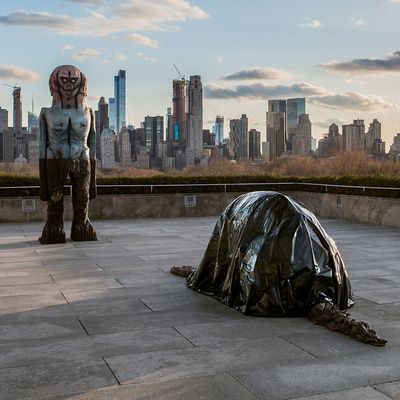
Huma Bhabha’s Frankensteinian bronze effigy/representation of an enigmatic many-faced, double-sexed Ozymandias, now on the roof of the Metropolitan Museum of Art, is more than a sculpture. Forged in a sculptural infinity of myth, divination, history, religion, war, sacrificial statues, and hallucination, it’s closer to an idol — which makes it eerie, other, unnerving, ambiguous, even alarming.
Up on the roof, the work — called We Come in Peace — is paired with an 18-foot-long figure facing it, garbed in a burka-like black garbage bag, bowing in obeisance while sporting an excremental reptilian tale and enormous Philip Guston–like hands. This second sculpture is Benaam, the Urdu word for “unnamed,” a semi-human pupa which, in combination with We Come in Peace throws us into the contested space of gods, ruins, Neolithic sculpture, and Modernism. Perhaps the figure summoned the statute or the statue called upon the figure, or maybe America has called them both into being. Regardless, this is among the best Met roof sculpture installations since the program began in 1987.
To look upon this grouping is to recall that the world’s four major monotheistic religions — Islam, Judaism, Christianity, and Zoroastrianism — which all share an Old Testament prohibition against likenesses like these. In Exodus, Leviticus, Isaiah, and Deuteronomy, God doubles down on the interdiction of the Second Commandment, saying that the making images or statues is an “abomination unto the Lord.” This God, in other words, is jealous. Of what? Of the gods worshipped by others — not just in Judea and Palestine, but hundreds of others out of Africa, in Egypt, Greece, and pouring in from the East and from the western Mediterranean. Even for God, the world is overrun with competition.
On the Met roof, Bhabha’s work lunges into the absolute present. Her vivisected, gouged idol covered in blotchy graffiti could be from any photograph seen daily of the mayhem in the Middle East, just part of the carnage, interventions, and wars she has called a “systematic demonization and humiliation of the people and their ancient and present Islamic cultures.” Bhabha lets us gather what has arisen in the wake of Western police actions, sanctions, coups, shadow governments, missions accomplished, invasions, interventions, and our almost constant warmongering against black, brown, Asian, Arab, and Muslim cultures. Her Met installation is a vivid rebuke of what the West says to all the cultures it invades: We come in peace. It has been said that America brings a desert and calls it peace. This is that desert conjured on the roof of the Met.
In a previous interview about her work, Bhabha has said, “I’m from a broken place, living in a breaking world [and have seen] the long term residual effect of colonialism and imperialism … [and] physical destruction happening in different parts of the world” that makes “functioning cities look like archaeological digs.” Then she goes a step further, saying, “What the Western Heritage Foundation considers valuable” — meaning ancient monuments, religious structures, buildings, antiquities, and archaeological sites — are more worth saving and protection than current “cities and villages with human life.” She’s saying that in the grotesque logic of multifaceted Western imperialism, art is now more worth saving than people and that most of the visible efforts being made are for objects — not human beings. She’s right; we’re wrong. We placate ourselves with charity drives to “rescue” temples while being among the most destabilizing forces on Earth, creating power imbalances that lead to these exact destructions, and by being the largest arms dealers in the world.
This way of “caring” is, Bhabha says, merely how we live with ourselves — nd another way of indulging our cultural prejudices. Witness the recent TV show Civilization, in which the idea of culture being systematically destroyed is illustrated only by images of fanatical Middle Eastern groups blowing up Afghan monuments. All news follows the same pattern, never giving us the destruction carried out by Western drone warfare, helicopter assassinations, the bulldozing of villages, the imprisonment of whole populations, destruction of refugee camps, hundreds of thousands of bombing sorties, strategic actions, or ongoing proxy wars. Indeed, almost none of the dead bodies from these wars shown in America media have been American bodies. Those are too sacrosanct. Only the bodies of the invaded are pictured.
We Come in Peace and Benaam let us glimpse just how totally our world of images has been controlled — and distorted — by the West and Western imperial values and experiences: the undeclared oil wars, and dead efficacy of American ethics and geopolitical strategy.
It rings with the drumbeats of American-sponsored petrochemical wars, bunker bombs, and IEDs in Fallujah, Kabul, Somalia, Jakarta, Gaza, Sadr City, Ramallah, and Beirut. We glean American statecraft, carpetbaggers in Kuwaiti oil fields, Halliburton contractors overseeing the extraction of Iraq’s oil, the charnel house of our cretinizing xenophobia, and horror of losing control over the sources of our energy.
Bhabha’s sculptures show us that these are the lunatic impulses in American heads, heads incapable of seeing our own failed state as failed, deaf to the official slogans and banalities we employ to justify our actions, the hypermilitarized rifling of other countries’ resources armored in this superiority complex. We Come in Peace made me glimpse something else, too. Rather than focusing on any of this, and paying scant attention to the rot in our own country and refusing to address the seriousness of climate change, we’ve created the 24-7 sideshow fixation on the impossibility of having elected Donald Trump as president.

